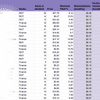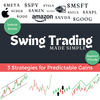
📊 Unlock Powerful Stock Charts!
Get real-time data, custom indicators, and in-depth stock analysis with TradingView.
Try TradingView FreeSwing Trading Secrets: How to Trade Successfully Without Quitting Your Job
Wed, Feb 12, 2025
Table of Contents
- Can You Trade Part-Time While Working a Full-Time Job?
- Why Did I Switch from Day Trading to Swing Trading?
- Which is More Profitable: Swing or Day Trading?
- What is the Downside of Swing Trading?
- Do You Need $25,000 to Swing Trade?
- What’s the Best Part-Time Trading Strategy?
- How Do You Find Stocks to Swing Trade?
- Should You Keep Day Trading and Swing Trading Accounts Separate?
- How Long Should You Hold a Swing Trade?
- Is Swing Trading Risky for Beginners?
- Why Swing Trading Works for Part-Time Traders
- What’s Your Trading Style?
Can You Trade Part-Time While Working a Full-Time Job?
Of course, you can. I started trading over a decade ago while working a full-time job. For three years, I managed to trade part-time, squeezing in time before work to plan and execute trades. Back then, I relied heavily on day trading, but honestly, it’s not always the best approach for part-time traders. If you’re working a regular job, you need something more flexible—and that’s where swing trading comes in. For instance, swing trading strategies like those I discussed in my NVIDIA analysis can be incredibly effective for part-timers.
Why Did I Switch from Day Trading to Swing Trading?
Day trading has its perks, but it’s intense. You’ve got to be on your toes, glued to the screen, and ready to act fast. It worked for me when I had fewer responsibilities, but as my life got busier, I needed a strategy that fit my schedule better. Swing trading was the answer. It lets me take my time. I can scan for trades midday or in the evening, hold positions for days or weeks, and let the trades work for me. So far over the year, this approach has taken me from $0 to over $200k.
If you’re curious about other ways to adapt trading to your lifestyle, my Shopify earnings preview explores long-term investment strategies alongside short-term opportunities.
Which is More Profitable: Swing or Day Trading?
Honestly, it depends. Day trading can give you smaller, faster profits because you’re in and out of the market multiple times a day. Swing trading, on the other hand, allows you to ride bigger moves and compound gains over time. I’ve found swing trading to be more profitable for me because it fits my lifestyle better. You don’t need to chase every market move, which also makes it less stressful. I’ve used this strategy successfully with stocks like those in my Semtech earnings analysis, where timing and patience played a huge role.
What is the Downside of Swing Trading?
Swing trading isn’t perfect. One of the biggest downsides is overnight risk. Since you’re holding positions overnight, you’re exposed to news or events that can cause big price gaps. Another challenge? Patience. Swing trading takes time—you’ve got to wait for the right setups and let your trades develop. And because it’s slower than day trading, you might miss out on short-term market opportunities.
If you want to dive deeper into market volatility and how to handle risks, check out my analysis of Intuitive Machines for a real-world example of navigating uncertainties.
Do You Need $25,000 to Swing Trade?
Nope. The $25,000 rule only applies to day traders under the Pattern Day Trader (PDT) rule. Swing trading doesn’t fall under that because you’re holding positions overnight. You can start swing trading with much less—just check your broker’s requirements. I’ve seen traders start with as little as a few thousand dollars and grow their accounts steadily.
What’s the Best Part-Time Trading Strategy?
If you’re working full-time, swing trading is your best bet. My go-to strategy these days is all about event-driven setups. I look for stocks breaking out above key resistance levels with strong catalysts, like earnings beats or big news. For example, I’ve used this approach with stocks covered in my SoFi analysis. The beauty of this strategy is that I can scan for trades in the afternoon and enter positions when it’s convenient for me. No need to wake up at the crack of dawn or stare at charts all day.
How Do You Find Stocks to Swing Trade?
Finding swing trades is pretty straightforward. I use stock scanners to spot midday movers—stocks with big volume spikes or strong breakouts. These are often driven by news or earnings. You don’t have to catch the move immediately, either. Even entering a day or two later can still work out great. Swing trading is forgiving like that. If you’re curious about earnings-related setups, you might enjoy my Palo Alto Networks expectations, which dives into timing trades around major news.
Should You Keep Day Trading and Swing Trading Accounts Separate?
Yes, 100%. Mixing the two can mess with your discipline. When you’re day trading and swing trading in the same account, it’s easy to panic-sell a swing trade because of what’s happening in your day trades. Keeping separate accounts helps you stick to your plan. I use Interactive Brokers for my swing trades—it’s super user-friendly, and their mobile app is great for managing trades on the go.
How Long Should You Hold a Swing Trade?
It depends on the trade. If it’s not working, I cut my losses quickly—usually within 1 to 7 days. But if it’s trending in my favor, I’ll hold for at least 2 weeks, sometimes over a month. The key is to keep losses small and let winners run. That’s what makes swing trading so rewarding for me.
Is Swing Trading Risky for Beginners?
There’s risk in any kind of trading, but swing trading can be more forgiving than day trading. You don’t have to watch the market all day, and you’ve got more time to plan your entries and exits. That said, you still need to manage risk. I’ve had my share of losses, but by cutting losers quickly and focusing on high-quality setups, I’ve managed to stay ahead. For beginners, starting with setups like those I reviewed in my Sea Limited analysis could be a great way to learn.
Why Swing Trading Works for Part-Time Traders
Swing trading is perfect for a busy schedule. You don’t need to be glued to your screen, and you can plan trades on your own time. Whether you’re working a 9-to-5 or juggling other responsibilities, it’s a flexible way to trade. And the best part? It’s not about trading every day—it’s about making the right trades that align with your goals.
What’s Your Trading Style?
Are you more into day trading, swing trading, or a mix of both? I’d love to hear what works for you. If you’re curious about my strategies, I’ve put together a swing trading crash course where I break down everything I’ve learned over the years. Check it out, and let me know your thoughts.
Original Tweet 👉
Not financial advice, just sharing my thoughts!
Related Posts
Gross Margin - This One Metric Can Make or Break a Business — Here's Why
Thu, Jun 5, 2025
Learn how gross margin works, why it matters to investors, and what it reveals about a company’s pricing power and cost structure.
Don’t Buy Another Stock Until You Understand Debt/Equity Ratios
Wed, May 28, 2025
Learn how to use the debt/equity ratio to assess a company’s risk, spot red flags, and make smarter investing decisions—without the finance jargon.
KULR ($KULR) Stock Analysis: NASA Partnerships, Bitcoin Strategy, and Key Risks
Fri, Dec 6, 2024
In-depth analysis of KULR stock, exploring revenue growth, NASA partnerships, Bitcoin strategy, and the risks in battery safety and EV markets.
🌟 Buy Me Coffee
Love the market insights, stock analyses, and investing tips I share? Help me do more by buying me coffee. Your support funds deeper research, keeps content ad-free, and helps create more tools and resources for the community.


